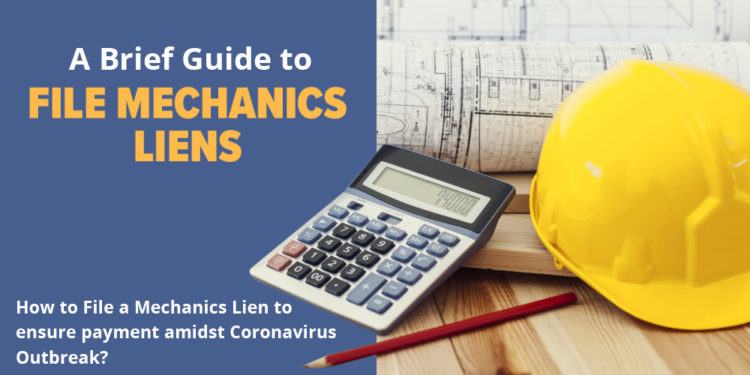A Mechanics Lien is a legal tool that is used by contractors, suppliers, and other third-party workers in the construction industry to ensure that they get paid the money that they have earned. It guarantees payment to the contractor, so it is also called a “collateral” or a “security interest.” Regardless of the name, the document helps the contractor get payment for his work.
Contractors and suppliers have a right to file a Mechanics Lien when they don’t get paid on construction works. Given the current global coronavirus pandemic and the economic situation, contractors should consider this option in case they feel payment will not be made by the owner.
A Brief Guide to File a Mechanics Lien
A Mechanics Lien freezes the property the contractor has to be paid for. It means that until the payment has been settled, the property cannot be sold by the owner, and if still unpaid, the contractor can sell the property through foreclosure.
Following are the major steps to file a lien:
1. Determine whether you have the right to file a Lien
The first and foremost step is to determine whether you have a right to file a lien. It is essential because if you file a lien and have no right to, then this is considered as a “frivolous lien,” costing you an expensive, lengthy lawsuit. Consider the following questions to determine if you have a right to file a lien:
- Does your work qualify for Lien protection?
There are several hundred kinds of services and roles in construction projects. Some roles can file Lien and some that don’t have a right. The traditional parties, like the general contractor, subcontractors, and third-party suppliers, have a right in almost all cases.
However, things become tricky with services like architects, designers, equipment, rental companies, etc. So make sure to consult a delay expert who can guide you with filing the Lien and help you in determining whether you have a right to file or not.
- Do you have to send a notice to the owner?
Most countries have a notice requirement that says that the claimant has to send a notice to the owner before the Lien. There are two major types of notices to keep in mind.
- Preliminary Notice: Authorities require
contractors to send this notice to the owner at the beginning of the work. If
you did not do so, then you lose your right to a lien. Since you have to send
it at the beginning, you probably don’t have time now considering the
coronavirus outbreak. - Notice of Intent to Lien: if your
authorities require this, then you send the notice to the owner before filing
the Lien. But make sure to send it soon, so you don’t risk missing the lien
deadline.
2. Drafting the Lien Form
After determining that you have a right to file a mechanics lien then you start preparing the document. You can either download the lien form online through your authority’s official websites. Or you get access of mechanics lien forms through delay experts or construction attorneys. Pay attention to following details:
- The Lien Amount:
When you file the Lien, the authorities require that you identify the unpaid amount in dollars. It is your “Lien Amount.” But there are a lot of questions when it comes to calculating the lien amount. For example, if the work is uncompleted, then only include the amount for the work and materials delivered.
- The Claimant Name:
This is one of the most common mistakes made by contractors when they file a lien. Answer the following questions: what is your trademark? Do you have a joint venture? Do you have “LLC” in your name? If you don’t put your correct name of the forms, the other party can challenge your Lien. To avoid that, use your legal name.
- Property Description:
As you are filing a lien against the property, so you need to identify it so the Lien gets indexed correctly. If you fail to do that, your Lien becomes invalid. To avoid such mistakes, use legal property descriptions or consult from legal construction advisors regarding your property description.
3. File your Lien with the authorities
Once you have the right and prepared the lien form, you are ready for the third step. You can finally file your Lien. Do not file a lien in a country where you are located, or the property owner is located. Lien claims need to be registered in the country where the construction property or the job site is located.
Many countries have strict compliance guidelines that you have to follow to ensure that your Lien does not get rejected. These include typos, filing fees, document formatting, paper size, margins, etc. Thus it is wise to consult a private delay expert or the recorder’s office of the country ahead of time to get information regarding the specific guidelines for filing a mechanics lien.
Keep Your Options Open
When a contractor files a Lien, he breaches the contract with the owner. It has no legal consequences, but contractors usually keep it as a last resort because it potentially ruins their business relationship with the clients, especially in case of a long term project. Before filing, you can send a notice of intent to lien.
However, if you are being cornered, then forget about your reputation and consult a delay expert for filing the Lien because otherwise, you are probably going to get burned especially when you have a shortage of funds in the future. After you successfully file the Lien, notify all the parties affected by the Lien, and send them a copy of your claim.
Also Read: Types of Stunning Flowers
